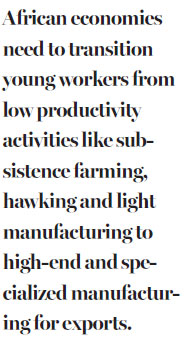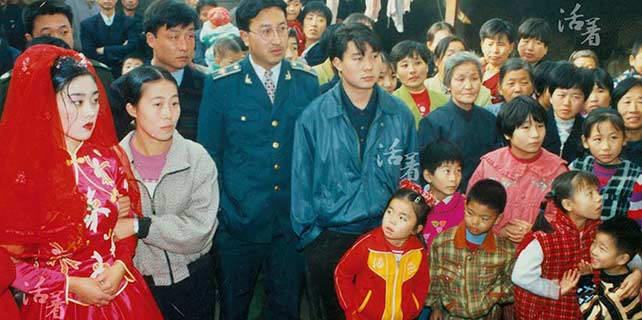African youth bulge: Curse or blessing?
More advanced occupations are needed to avoid problems caused by a burgeoning young population
Whether or not a country's labor market can absorb its rising workforce depends upon the size of its youth cohort. China is a good example of this economic dynamic. Since the early 1990s the country has seen nearly 8 million new workers a year enter the labor market. Arguably, for the last decade, this dynamic can be linked to the astronomical growth of the Chinese economy in the international system.
China's meteoric rise into an economic juggernaut has been fueled by four economic drivers: capital-intensive heavy industries dominated by the state; exports, led by specialized manufacturing; construction; and energy.
These sectors have absorbed a lot of low-skilled youth workers with a primary and junior secondary education - especially young migrants from rural areas.
This is not to intimate that the country is not grappling with unemployment in its massive economy. The 2012 China Household Finance Survey puts China's youth unemployment rate (15-24 age bracket) at 9.6 percent.

This figure is not high. However, the International Labor Organization predicts it will weigh in at 11.1 percent for 2016. In light of this, China has enacted reforms geared toward enhancing the professional and creative services sectors in these industries to absorb both tertiary and university youth. By doing this, the so-called jasmine revolutions are mitigated in the country and the traction of economic growth is maintained.
African crisis
By contrast, for Africa, the youth bulge phenomenon presents a bleak picture. This year, the African Union held its 28th Summit in Addis Ababa, Ethiopia, at its headquarters in late January. The AU theme is "Harnessing the Demographic Dividend through Investments in Youth". In light of this, the new chairman of the AU, Moussa Faki Mahamat, will have his work cut out for him in turning the burgeoning youth population into a demographic dividend instead of a curse.
Africa's demographics are showing a ballooning youth population - what some analysts call the "youth bulge". It is postulated that Africa has the largest youth population in the world.
At present, the population between the ages of 15 and 24 years stands at about 200 million. According to the 2012 African Economic Outlook report prepared by experts from the African Development Bank, the UN Development Programme, the UN Economic Commission for Africa and the industrialized countries' Organization for Economic Cooperation and Development, this figure will double by 2045, given the current trend.
According to the World Bank, in the next decade Africa's population between 15 and 29 years of age will reach 28 percent of the total. The populations of Burkina Faso, Malawi, Niger, Mali, Somalia, Uganda, Tanzania and Zambia are predicted to increase by 500 percent. The global population is expected to reach 10.9 billion by the end of the century, with Africa contributing the largest cohort.
The fear of African policymakers is that because of the youth bulge many countries on the continent may become hotbeds for political uprisings and unrest. The current situation is that a large segment of youth cannot find employment. According to the World Bank, 60 percent of all African youth unemployed.
According to the African Economic Outlook, more than 70 percent of African youth live on less than $2 per day (1.89 euros; 1.65) - the internationally defined poverty threshold.

In North Africa, the youth unemployment rate is 30 percent. It's even worse in Botswana, the Republic of the Congo, Senegal, South Africa and several other countries. A World Bank survey conducted in 2011 found that 40 percent of youth who joined rebel movements were motivated by a lack of jobs. Thus, of the 67 nations that were experiencing youth bulges, 60 were experiencing civil strife and conflict.
China model applied
Africa will do well to borrow a leaf from China in managing the youth bulge. As earlier stated, African economies need to transition young workers from low productivity activities like subsistence farming, hawking and light manufacturing to high-end and specialized manufacturing for exports - and further, especially in regard to agrarian activities, facilitate access to funds to enhance value chains overall.
This is because, over the last 50 years, very little attention has been paid to both the agro-allied and entrepreneurship sectors that transform farm inputs into final products. These sectors are attractive for several reasons. First, a large youth population in Africa is concentrated in these sectors. A World Bank report showed youth employed in these sectors in Mali at 94 percent, Ethiopia at 74 percent and South Africa at 31 percent. Second, the formal skill requirements are typically low at the beginning, thereby allowing youth to learn gradually as they transition to more sophisticated tasks. Last, these sectors are labor-intensive.
This paradigm shift is anchored in new structural economics, which holds that a country's economic development is built into its endowment structure. Therefore, for African countries to be successful in harnessing the youth bulge, they need to concentrate on their comparative advantages as determined by their endowment structures.
For example in Kenya, our key endowment structures are in agriculture and technology. Pursuant to this, the Kenyan government in its Vision 2030 identified information technology as a key driver for development in which youth are heavily interested. It is expected that this sector can generate 20,000 jobs.
The author is a political strategist at the African Policy Institute in Kenya. The views do not necessarily reflect those of China Daily.
(China Daily European Weekly 03/17/2017 page12)






















